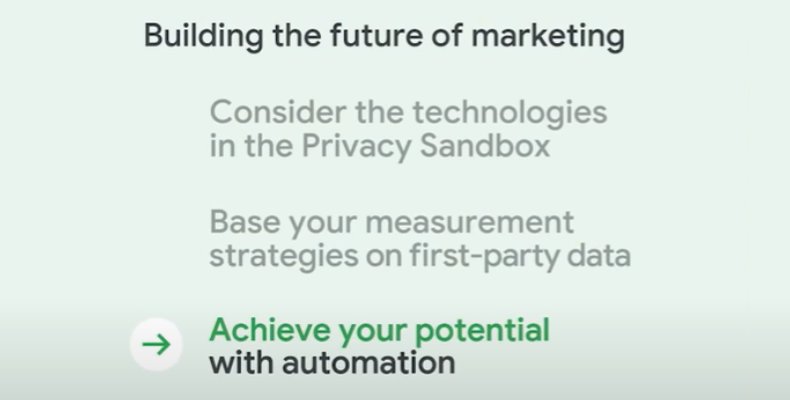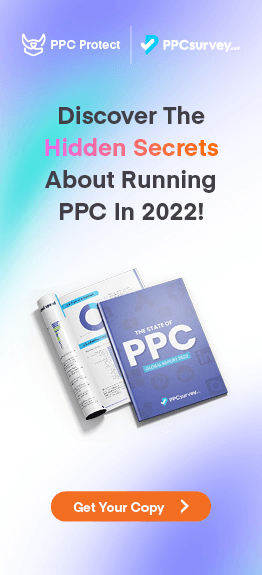Our Digital Marketing Manager, Matthew Erskine, unpicks the two main themes of Google’s Marketing Livestream – automation and privacy – and asks the questions on everyone’s lips: what do they mean for the future of marketing, and what we can do to get ahead of the game?
If you’re looking for a full roundup of the event to draw your own conclusions, check out our highlights article.
What To Do About The Impending Takeover Of Automation?

Google really wants us to use automation. This is something we’ve known for a long time, but they’re now being increasingly open about how they see it playing an integral part in the future of marketing. In fact, a direct quote from the event was “use machine learning and automation wherever it is available.”
Whilst Google Ads’ automation currently leaves a lot to be desired, it’s clear they see automation as the solution for many of our time-old problems; machine learning will pave the way for real-time responses to changes in consumer demands and behaviors, as well as being the best way to optimize across all paid channels.
Lesson 1: Automation Is Moving Far Beyond Just Automated Bidding
Google’s reliance upon automation will roll out across the entire Google Ads space. Everything from bidding strategies, audience targeting, and ad creatives will be affected.
We are really going to have to start trusting Google’s instincts and machine learning if we continue to invest in their platform.
So, my advice would be to start now. Test automation in your campaigns; try different smart bidding strategies and see which work best for you. Get your head around what does and doesn’t work in your accounts, figure out which aspects you’re happy to lose a little control over and which you need to find ways of keeping control of for as long as possible.
It’s also worth noting that Google is significantly reducing the time campaigns have to spend in the learning phase. This means changes can now be made to automated campaigns with little disruption – so keep your eye out for swift changes.
Lesson 2: We’re Going To Have To Start Embracing BuMs
The future of keywords is BuMs. (That’s what I’m calling ‘broad unmodified’)
Here’s my prediction: the next phase of keyword targeting will be simplified to ‘Exact’ and ‘Broad Unmodified’ keywords. My logic comes from the way in which we’ve already seen Exact Match slide closer to the traditional Phrase Match, and Phrase and Broad Modified are merging into one. With Google now focusing on BuMs, it makes sense to simplify things further.
The theory is that as 15% of search queries every day are brand new, BuMs are required to ensure your campaigns are agile enough to appear for new queries. The formula, according to Google, is to use RSAs with board match keywords and smart bidding and to let Google do the rest.
This is something I’ve tested recently, with interesting results. The account I tested this on was spending around £100,000 PCM, in the UK in a competitive niche.
These were my findings:
- CPCs plummeted: we started driving traffic much more reasonably, and our spend drives a lot more traffic to the site.
- Traffic quality worsened: engagement metrics were impacted, conversion rate almost halved.
- If you use Search Impression Share as a key metric when analyzing campaign performance, you’ll have to stop – ours dropped from around 85% to less than 20%.
- We lost control of spend for a few days but it soon righted itself.
- Conversion volume and cost per conversion stayed pretty much the same. So, whilst there was no net benefit, it didn’t have a negative impact either.
For this case, Google’s claim of increasing conversions by 20% wasn’t true. Despite this, we made the decision to phase all campaigns to the new strategy. Whilst we’re still using Exact and Phrase match keywords in our accounts, but we also bid on BuMs. So far we haven’t seen our performance worsen, but this means we stay ahead of the game.
Lesson 3: Creativity Will Become The Competitive Edge
Google often makes subtler points, just once or twice, but they can give you a real insight into the values they deem important for future success. In this case, it was creativity.
With automation soon to be taking care of most of the tactical decisions, creativity in ads will set us apart from our competitors. To prepare for this now, start working on your processes. Make it the norm to create outstanding creative and ad copy on a regular basis. Keeping ads fresh and engaging is going to become ever more important.
Lesson 4: Quality Score Is Going To Be The Mother Of All Metrics
Whilst we may not have to concern ourselves with CPCs and CTRs for much longer (those metrics will be highly manipulated by automated strategies), Quality Score will remain a vital metric to keep your eye on.
Google is improving the reporting on this and helping to make it more transparent as they see it as a key performance metric in steering our automated ad accounts.
This means now would be a great time to learn as much as you can about Quality Score in Google Ads.
Lesson 5: Performance Max Campaigns Are The Future
Google proudly announced that Performance Max campaigns are now available to ‘most advertisers’.
This campaign type will consolidate all of Google’s ad inventory including Search, YouTube, Display, Discover, Gmail, and Maps, and give advertisers expanded reach without having to manage multiple campaigns.
Excitingly, new reporting is coming to Performance Max campaigns. They are going to report on top-performing creatives, auction insights, and trending search categories. We will be able to preview our best ads on each channel and demand forecasts will soon be added to the Insights page, predicting changes in search behavior for the next 90 days.
I hope that this level of insight will be universal across all campaign types and not just available for Performance Max campaigns.
Lesson 6: Automation Is Making PPC A Strategic Game
A question that often comes up when I’m talking about automation with other marketers is ‘what will the future role of the PPC manager be?’
Personally, I think that the changes that are coming are exciting. PPC is moving away from being a tactical game of diving into small data points and making incremental changes for incremental gains. Instead, it’s becoming about the bigger picture. It’s big data and big strategic changes. It will, I hope, elevate the role of the PPC manager to one that more comfortably sits around the table when discussions of strategic direction are being held.
The Time To Act On Privacy Is Now

Another unsurprising, but important topic which dominated talks was privacy. Google claims that 81% of people say that the potential risks they face from data collection outweigh the benefits, demonstrating the prevalence of privacy concerns. That’s huge, and it’s going to shape the next few years of digital marketing.
Lesson 7: Start Preparing For A World Without Cookies
We know it’s coming, and Google has a solution for us when it does.
They state advertisers should follow these guidelines for transitioning to a cookie-less world:
- Use consented, first-party data properly
- Be forward-looking and predictive, using automation and machine learning that help you identify patterns and trends
- Commit to new technologies that preserve privacy, such as Google Chrome’s Privacy Sandbox

We should all be using first-party data rather than relying on tracking cookies. The way in which we achieve this is by building great relationships with customers and showing them that they can trust you. Gaining consent by building deep engagement and properly third-party data is the way forward.
If you’re not already responsibly collecting and using first-party data, it’s time to start figuring out how you can.
Now is also a good time to review your marketing funnel, and start identifying the points at which you could start collecting (or better using existing) first-party data to benefit your audience – 54% of people are willing to hand over their personal data if it results in an improved, personalized experience.
The likely outcome of these changes is that companies will return to gating all their content. Whilst this is not ideal, in order to make people fork out for admission, they’ll need to ensure their content is of high value. So, that means there’ll be fewer 4-page ebooks that provide little insight, and more research-led, valuable content that is exclusively available to subscribers.
From there, Customer Match will then let us upload on and offline customer data to campaigns, which should improve targeting. There will also be an integration with Salesforce, and an API with Zapier, so unless you’re a fan of downloading and uploading CSVs, you’ll need to figure out how easy it is to connect your CRM to Google Ads.
Finally, Google didn’t offer many solutions in the way of expanding prospecting audiences. We will still be able to utilize an element of demographic targeting but whether it will remain as effective we don’t know. My prediction is that behavioral targeting and ad placements are going to become vital for display campaigns.
Lesson 8: There Are Solutions To Tracking And Measurement Post-cookies
Once third-party cookies are phased out, Google states it will not build alternative identifiers to track individuals as they browse the internet.
Instead, they are introducing new ways to enable conversion tracking without personal data. Enhanced conversion measurement allows you to measure conversions when cookies are not available; this will let your tags use consented, hashed first-party data like email addresses, from wherever your conversions are recorded. Layered on top of this will be conversion modeling, which utilizes machine learning to fill in the gaps of missing data
As mentioned earlier, the future relies on us all putting an awful lot of trust into Google, and this might be the pinnacle of that. Conversion modeling is undoubtedly very intelligent and will be highly useful.
However, personally, it’s going to take some time before I’m making strategic decisions based on modeled conversion journeys. I fear that this is yet another feature that will be of far more benefit to big brands with big budgets and lots of site traffic, and less so to smaller brands and start-ups.
So, to summarize, here’s how we’re going to be coping in a post-cookie world:
- Sitewide Tagging: using enhanced conversion measurement.
- Customer Match: reach leads, customers, and new users using first-party data.
- Consent Mode: start setting this up today!
Other Points To Note
- Demand forecasting will be rolling out in the coming weeks, which will be able to predict search and session numbers for the next 90 days on a website.
- We can now remove a period of time from conversion history reporting. So if you know you had a couple of days that were impacted by testing, or cookie model issue, or invalid clicks then you can make that data disappear from reports.
- A price competitiveness report is to be added, allowing you to see which prices get the most clicks.
- They are extending their best-in-class modeling in Google Analytics which will improve their cross-channel tracking and attribution models – something I’m very excited about!
- YouTube and Display touch-points will soon be included in attribution models which is huge. They didn’t say whether this will include view-through numbers, but we really hope so.
- They are building YouTube more towards both engagement and action, so we’ll hopefully see the platform driving more direct conversion rather than having to rely on view-throughs to justify spend.
- Image extensions are out of beta!
- Local inventory ads will highlight retail products that are available for immediate in-store pick up, curbside pick up, or pick up at a later time.
- Instagram-style stories are being added to Google as they want to give us more opportunities to show our audience who we are as a brand.
And that’s all from me for now, but feel free to reach out to me on social media if you fancy a chat about any of these topics. As always, a reminder to only optimize your campaigns based on clean data – don’t let invalid clicks skew your marketing decisions!


